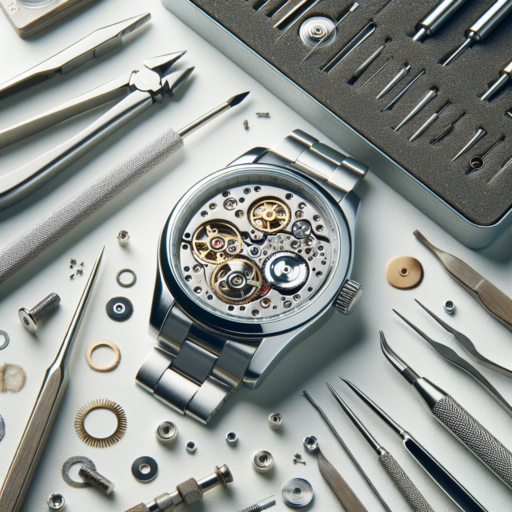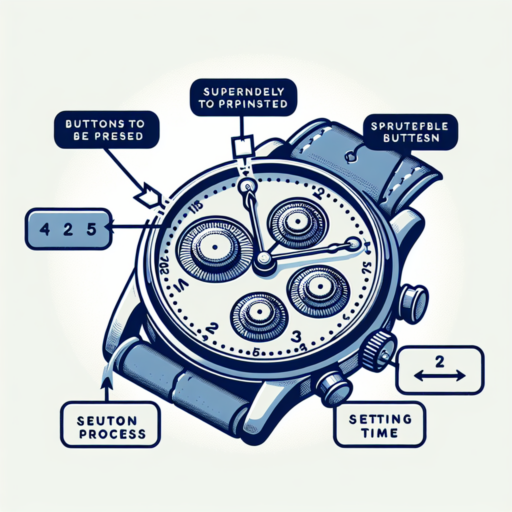Introduction: Preparing to Disassemble Your Wrist Watch
Disassembling a wristwatch can be an intricate task that requires precision and careful preparation. Whether you’re looking to perform a basic cleaning, diagnose an issue, or simply familiarize yourself with the intricacies of your watch, understanding how to properly prepare for disassembly is crucial. This guide aims to provide the necessary steps and precautions to ensure a successful disassembly process, minimizing the risk of damage to your valued timepiece.
First and foremost, it’s important to gather the right tools. A set of high-quality watchmaker’s tools is indispensable for safely disassembling a watch. This kit should include specific screwdrivers, tweezers, a case back opener, and a movement holder, among others. Keeping these tools organized and within reach will streamline the disassembly process and protect the watch’s delicate components from accidental damage.
Before diving into the disassembly, it’s essential to create a clean and organized workspace. A well-lit area with a soft, static-free surface will not only protect the watch’s parts but also help in keeping track of tiny screws and components that could easily be lost. Additionally, wearing antistatic gloves can prevent smudges and fingerprints, preserving the aesthetic integrity of the watch during the process.
Step-by-Step Guide: How to Take a Wrist Watch Apart
Taking apart a wristwatch can be a fascinating but daunting task, whether you’re aiming to clean it, repair it, or simply satisfy your curiosity on how the timepiece ticks. Before diving into the disassembly, it’s crucial to remember that watches consist of tiny, intricate components. Thus, a steady hand and patience are paramount. Below is a streamlined guide designed to navigate this meticulous process successfully.
Preparation and Initial Steps
Start by creating a clean, well-lit workspace to ensure all small parts are easy to see and not lost. Equip yourself with the right tools: a set of precision screwdrivers, tweezers, and possibly a case back opener, depending on your watch model. Remember to ground yourself to avoid static discharge that could damage the watch’s intricate electrical components, especially if it’s a quartz watch.
Removing the Case Back
The journey into your wristwatch begins with removing the case back. For screw-down cases, use the case back opener adjusted to fit the notches. For snap-off cases, carefully insert a case knife or a flat precision screwdriver into the notch and gently pry it open. Take note of any signs of resistance, as forcing the case can damage the seal or the case itself.
Disassembling the Movement and Beyond
With the back case removed, you’ll now see the heart of the watch — its movement. At this stage, it’s vital to proceed with extreme caution. Use the tweezers to carefully remove the battery (for quartz watches) or to slowly release the power in the mainspring (for mechanical watches) by gently turning the crown in the opposite direction of winding. Observing how the components fit together before you proceed further can prevent confusion during reassembly.
Tools You’ll Need for Disassembling a Wrist Watch
Disassembling a wrist watch can appear daunting, yet with the right tools, it turns into a manageable, if not enjoyable, venture. Whether you’re a professional watchmaker or a hobbyist aiming to dabble in watch repair, knowing which tools are essential is the first step towards success. This guide sheds light on the indispensable tools that should grace your workbench before you embark on disassembling any wrist watch.
Watchmaker’s Screwdrivers
A set of high-quality watchmaker’s screwdrivers is crucial for the delicate task of disassembling a wrist watch. These screwdrivers come in various sizes to match the minuscule screws often found in watch mechanisms. Look for a set that offers a range of sizes, ensuring you can handle any screw the watch presents. The precision and fit of these screwdrivers prevent damage to the watch’s components, making them an irreplaceable part of your toolkit.
Case Opening Tools
Before you can access the internals of a wrist watch, you’ll need to open its case. Case opening tools are designed specifically for this purpose, offering a safe and efficient way to separate the watch case without causing harm. There are different types of case opening tools, including wrenches for screw-back cases and knives for snap-back cases. Choice of tool depends on the type of case your watch has, but having both types at your disposal is advisable for versatility.
Tweezers and Loupes
Handling the minute components of a wrist watch necessitates the use of precision tweezers. Opt for a set that offers varying shapes and sizes to give you flexibility in picking and placing small parts. A loupe, on the other hand, is your window to the intricate world inside the watch. It magnifies small details, making it easier to inspect and work on the watch’s tiny mechanisms. Together, tweezers and loupes empower you to maneuver through the disassembly process with accuracy and confidence.
No se han encontrado productos.
Understanding the Parts of Your Wrist Watch Before Disassembly
Disassembling a wrist watch can be a daunting task, especially for those who are not familiar with the intricate details of watchmaking. Knowing the parts of your wrist watch is crucial before embarking on this meticulous process. It helps in avoiding damage and ensuring a successful assembly post disassembly. Each part of a wrist watch has its unique function and significance, contributing to the overall performance and aesthetics of the watch.
Casing and Movement
The casing is the outermost layer of the watch that houses the watch’s internal components. It includes the back cover, crystal, and crown, which are essential for protecting the watch’s inner mechanisms from dust, water, and external damages. Inside the casing, lies the movement, the heart of the watch. This can be mechanical or quartz, depending on the type of watch. The movement is responsible for the timekeeping function, and understanding its complexity is vital for anyone looking to disassemble their watch.
Dial and Hands
The dial, often referred to as the face of the watch, displays the time through a combination of indices, numbers, and rotating hands. It’s directly connected to the movement and works in synchrony to show accurate time. The hands of the watch, which include the hour, minute, and sometimes second hands, are delicate and require cautious handling during disassembly to prevent bending or breaking. Familiarity with the dial’s layout and how the hands are connected to the movement will serve as a guide through the disassembly process.
Strap and Buckle
While the strap and buckle might seem less complex compared to other parts, they are still essential for the functionality and wearability of the watch. The strap, which can be made of various materials such as leather, metal, or synthetic, determines the comfort and style of the watch on the wearer’s wrist. The buckle, on the other hand, secures the watch in place. Although they may not be directly involved in the disassembly of the movement and dial, knowing how to properly remove and attach the strap and buckle is important to avoid damage.
Common Mistakes to Avoid While Taking Apart Your Watch
Taking apart your watch can be a daunting task, fraught with potential pitfalls even for the experienced. While the intricate details of watch assembly require a delicate touch and precision, being aware of common mistakes can help you avoid damaging your treasured timepiece.
One of the most frequent missteps is using the wrong tools for disassembly. Watches are crafted with an extraordinary level of precision, and every component fits just so. Resorting to improvised tools like knives or screwdrivers not specifically designed for watch work can scratch the casing or damage the delicate internals. Employing professional-grade watch tools is not just recommended; it’s essential for avoiding unnecessary harm to your watch.
Another crucial mistake to steer clear of is rushing through the process. The intricate parts of a watch, including springs, gears, and pins, require patience and careful handling. A rushed job not only increases the risk of losing these tiny parts but can also lead to improper reassembly, which might cause the watch to malfunction.
Furthermore, failing to create a clean, organized workspace is a blunder with potentially disastrous consequences. Disassembling a watch involves keeping track of several small, easily misplaced pieces. Working in an unorganized space could lead to losing parts or mixing them up, compounding issues when it’s time to put everything back together.
By familiarizing yourself with these common mistakes, you can better prepare to take apart your watch with the care and respect it deserves, ensuring it continues to mark time accurately for years to come.
Troubleshooting: Dealing With Stuck or Seized Watch Parts
Experiencing stuck or seized parts in a watch is a common issue that can dampen the joy of watch ownership. Whether you’re a seasoned collector or a new enthusiast, understanding how to tackle these stubborn parts without causing damage is essential. This guide provides actionable advice to help you navigate the complexities of dealing with these challenges.
Identifying the Cause
The first step in troubleshooting stuck or seized watch parts is identifying the root cause. Common culprits include dried lubricants, dust accumulation, or corrosion. These elements can lead to the deterioration of watch components over time, ultimately causing them to stick or cease. By pinpointing the problem, you can apply the most effective solution without risking further damage to your timepiece.
Safe Practices for Loosening Parts
- Mechanical Manipulation: Gently rotate or wiggle the stuck part to assess if it can be loosened without additional tools. This should always be your first approach to minimize the risk of damage.
- Use of Lubricants: Specialty watch lubricants can be applied sparingly to the affected area. Allow it some time to penetrate and break down the buildup that’s causing the part to stick. Remember, a little goes a long way.
- Professional Tools: In certain cases, specialized watch tools may be necessary to address the issue. However, it’s crucial to use these tools with caution and precision to avoid scratching or harming your watch further.
Cleaning and Maintenance Tips for Disassembled Watch Parts
Keeping your disassembled watch parts clean and well-maintained is crucial to ensure the longevity and optimal performance of your timepiece. Whether you are a professional watchmaker or a watch enthusiast taking on the task of cleaning your own watch, understanding the best practices for cleaning and maintenance can make a significant difference. In this guide, we’ll share some essential tips to help you care for your disassembled watch parts.
Proper Cleaning Techniques for Disassembled Watch Parts
Cleaning your disassembled watch parts requires patience and attention to detail. Begin by preparing a clean, dust-free work area to avoid any contamination. Use a gentle brush to remove dust or debris from the parts before proceeding to any liquid cleaning solutions. For metal parts, a specialized watch-cleaning solution or isopropyl alcohol can be used. Ensure that the solution is compatible with your watch materials to prevent damage. Soak the parts for a specified amount of time before gently brushing them and laying them out on a lint-free cloth to dry.
Regular Maintenance Schedule
Adhering to a regular maintenance schedule is vital for the health of your disassembled watch parts. It is advisable to clean your watch parts every time you disassemble your watch, preventing the buildup of grime and oxidization that can lead to wear and tear over time. Additionally, lubrication is a key step in the maintenance of watch parts. Applying a small amount of watch-specific lubricant can prevent friction between moving parts, which is essential for the smooth functioning and longevity of your watch.
Reassembling Your Wrist Watch: A Comprehensive Guide
When it comes to reassembling your wrist watch, it’s a task that may seem daunting at first. However, with patience and the right tools, it’s a job that can be quite rewarding. This guide is designed to help watch enthusiasts of all levels confidently tackle the reassembly process. From ensuring all your parts are accounted for to aligning each tiny screw, we’ll walk you through the essential steps.
Step 1: Prepare Your Work Station
Before you dive into the intricate world of watch reassembly, preparing a clean and dust-free environment is crucial. Make sure you have a magnifying glass, a set of precision tools, and a soft cloth to protect your watch’s components. Organizing your workspace can greatly influence the efficiency and success of your reassembly process.
Step 2: Inventory of Pieces
It’s important to start by taking inventory of all the watch parts. Lay them out on a soft cloth in the order of reassembly. This not only helps in ensuring that no small piece goes missing but also aids in visualizing the reassembly sequence. Paying attention to detail during this step can prevent any mishaps during the actual reassembly.
Step 3: Reassembling the Movement
Reassembling the movement is arguably the most intricate part of the process. Carefully insert the gear train, ensuring each piece is correctly aligned and lubricated if necessary. Following this, the process of positioning the dial and hands needs to be done with utmost precision to avoid any damage. This step is crucial for the functional integrity of your wristwatch.
Remember, reassembling a wristwatch is a delicate procedure that requires patience, a steady hand, and attention to detail. By following these guidelines, you’re taking the first step towards restoring the beauty and functionality of your timepiece.
Professional vs. DIY Watch Disassembly: What You Need to Know
Choosing between seeking the expertise of a professional or opting for a do-it-yourself (DIY) approach to watch disassembly can significantly impact both the condition and functionality of your valuable timepiece. The decision often hinges on various factors, including the complexity of the watch, your technical skill level, and the potential risk of damaging your watch. Knowing the key distinctions and considerations can guide you in making an informed choice that aligns with your needs and preferences.
Understanding the Risks Involved in DIY Disassembly
One of the primary considerations in the DIY vs. professional watch disassembly debate is the risk involved. While the appeal of DIY projects lies in the potential cost savings and the satisfaction of personal accomplishment, watch disassembly is intricate and fraught with dangers. Minute components, specialized tools, and the precision required mean that a single misstep could result in damage to the watch mechanism, loss of essential parts, or a voided warranty. These risks are magnified in watches with complex mechanisms or luxury brands, where repairs can be prohibitively expensive.
Benefits of Professional Watch Disassembly
On the other hand, professional watch disassembly offers numerous benefits, chief among them being the assurance of quality and expertise. Experienced watchmakers possess the specialized tools, knowledge, and skills required to safely disassemble, inspect, and reassemble watches without causing damage. Professionals also often guarantee their work, providing peace of mind that if something does go wrong, the repairs will be covered. Additionally, for watches still under warranty, professional service is typically required to maintain warranty conditions, making the professional route more appealing for newer or luxury watches.
Conclusion: Enhancing Your Watch’s Lifespan through Proper Disassembly
Understanding the intricacies of proper watch disassembly is pivotal for every watch enthusiast looking to extend the lifespan of their cherished timepieces. The process, while delicate, plays a crucial role in maintaining the performance and aesthetics of your watch. It is not just about the immediate benefits of cleaning and repair; it also revolves around protecting the intricate internal mechanisms that are susceptible to wear and tear over time.
One of the key strategies for enhancing your watch’s lifespan through proper disassembly involves regular maintenance. Just like any high-precision instrument, a watch requires a meticulous level of care and attention. This means delegating the disassembly process to skilled professionals who understand the nuances of your watch’s specific mechanism. By doing so, you not only ensure a thorough and safe cleaning process but also preemptively address any potential issues that could escalate into more serious problems.
Furthermore, embracing the discipline of proper disassembly extends beyond preservation. It is also an investment in the enduring value of your watch. Whether it is a family heirloom or a personal luxury item, maintaining its condition ensures that it continues to function accurately and remains visually striking. This routine care underscores the symbiotic relationship between the owner’s commitment to their watch and the watch’s long-term performance and value.




